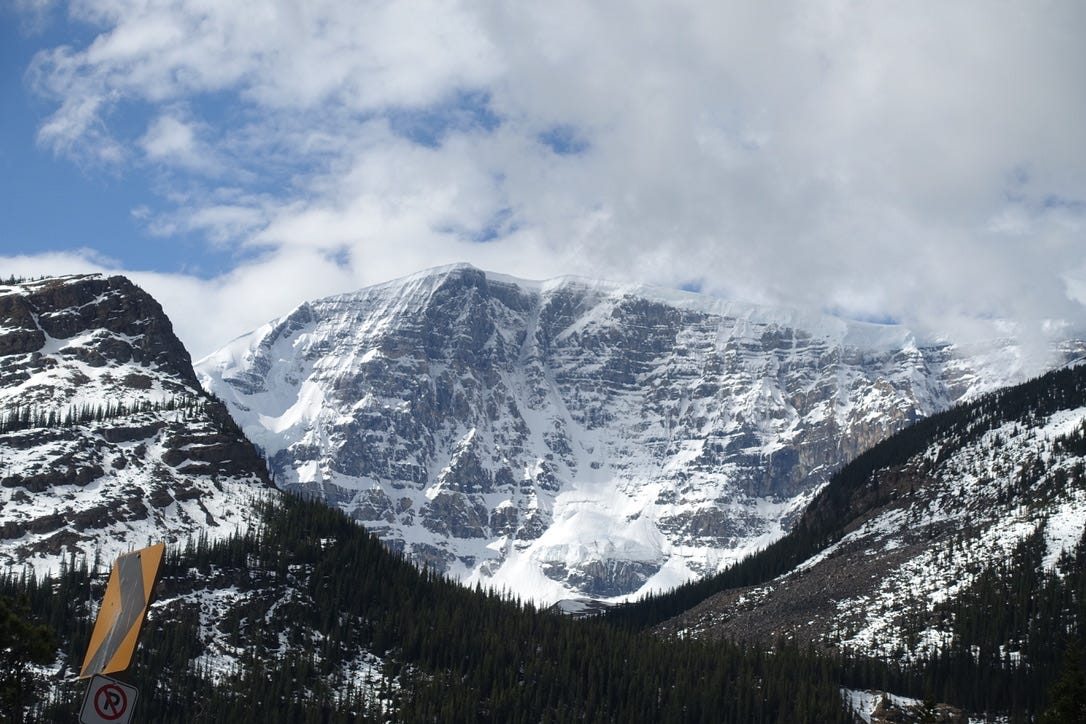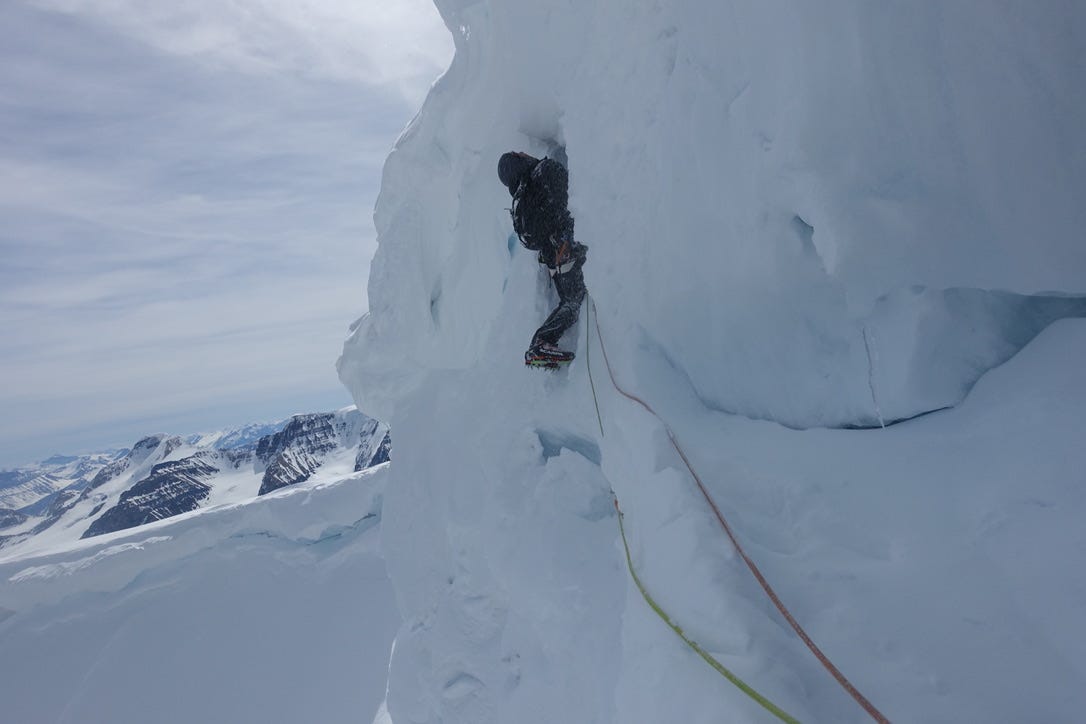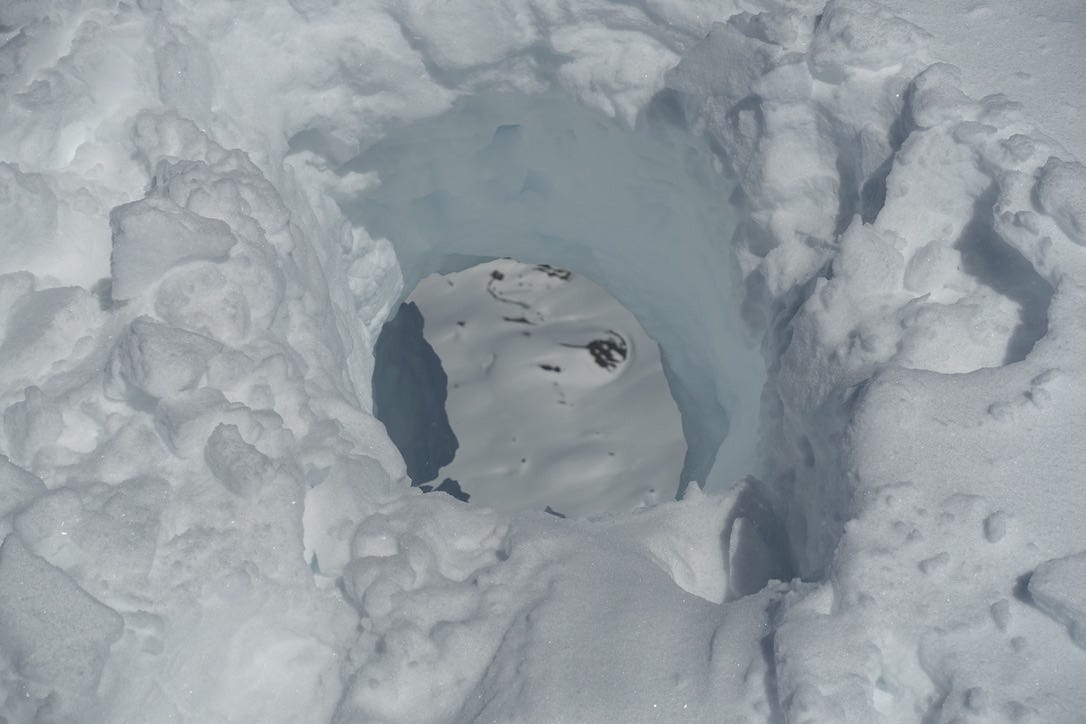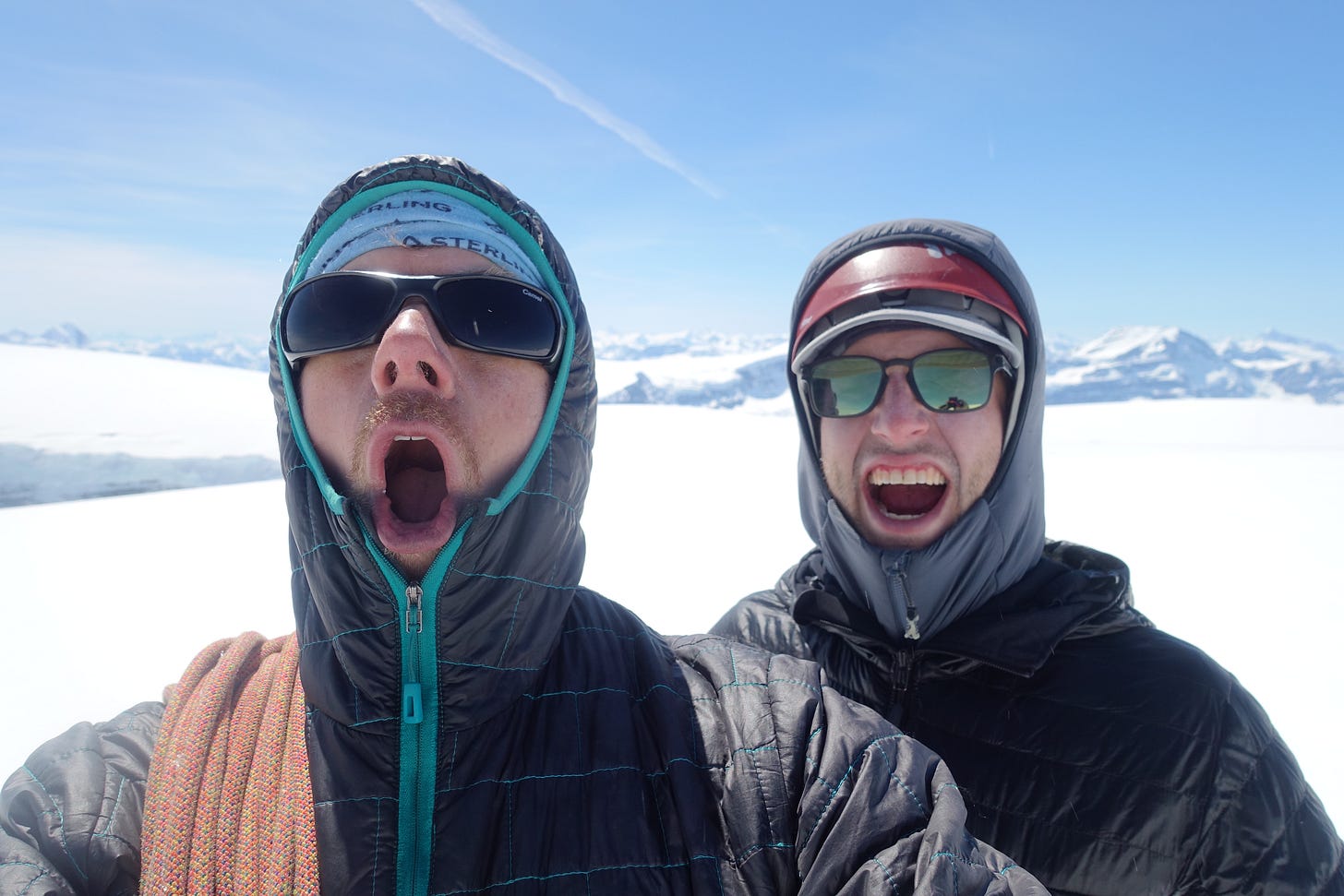I drove to the Rockies on Thursday May 10th, picked up Ethan in Golden in the afternoon, we shopped and drove to the Athabasca creek hostel arriving around 9:30 PM. Neither of us had slept well the night before so we slept in until 9:00 that morning, each clocking a good ten hours of sleep. We drove up to the icefields center stopping to snap photos of the GCC, and sat looking at the Andromeda strain and discussing our best option. Both routes looked like they were holding a fair amount of ice and snow, and neither would be bony. We decided moving quickly was important with the forecast (warm and sunny, freezing levels to 3000m), and the GCC was the better bet because we could likely through the entire route faster than the technical climbing on the Andromeda strain.
We packed up back at the hostel and returned to park on the GCC around 3 PM. Ethan crossed over Athabasca river in a little canyon, but it required a bit of scrambling that I wasn’t keen to do in mountain boots so I walked back upstream and waded across. The rest of the approach was relaxed, with quite a bit of sidehilling around to the mouth of the valley under the north face. We arrived at the base at 6 PM and set up camp.
As we knew we had to move fast, we sat for a while discussing where our decision points were on the route. We agreed on certain timelines for where we had to be on the face before deciding to continue, based on when we thought we could safely descend before things warmed up too fast. The question we would each answer ‘yes/no’ to was “Is there any reason not to continue right now?” If we disagreed it would warrant a conversation, if we agreed we would head up or down depending on the answer. Chris and I didn’t establish decision points previously and I think this was a big improvement in my risk-assessment framework.
We got about four hours of sleep before waking up at 2 AM. The night was clear and the glacier had frozen slightly, making a breakable crust until about 200m from camp, where things had really frozen and we could stand on top of the snow. We punched it to the base, stopping where the slope started to rise appreciably to put on harnesses and crampons. We started climbing at 3 AM.
Ethan and I simul soloed up the first 300m of the route, until the schrunds started getting big. We crossed one big gaper that was well bridged, and I started across another bridge that I thought looked solid. It woomphed and shifted underneath me and I backed off, scared. We found another spot to cross, I pulled one half rope out, and got into the schrund while Ethan climbed up over it. When the rope ran out he planted his axes and I climbed over. We continued up, simuling with the rope on (no gear) for speed. I belayed him over one more schrund.
When we turned into the couloir which led to the ice climbing higher up we were at another decision point (it was about 4:30 AM). We decided to continue up to the base of the ice climbing (we’d decided we needed to reach it at 5:30 AM to continue on). We punched it up steepening snow until we got to 70 degree ice at the base of the corner. We started simuling and climbed 100m before Ethan kicked off a dinner plate that struck me in the left boob. It was very painful so I told him to build a belay and bring me up. He continued up while I nursed my chest. It was a bad bruise but nothing broken. Ethan arrived at the base of the mixed corner and I climbed to him. It was just about 5:30 and we were on track.
The Blanchard Doyle ice strip looked good so I started climbing. This pitch offered very cool climbing with one axe in the strip and both crampons on rock, some moderate (m5-6) mixed moves, generally poor gear in the rock and good gear in the ice. Here sun hit the face up high and stirred up the wind, causing snow to shower down intermittently. This moment stands out- I was high on a north face using everything in my toolbox to climb and protect a complex 60m pitch while getting spindrifted. There aren’t many moments where I call myself an alpinist but that was definitely one of them. I think it took me 45m - 1hr to lead.
Ethan was following, approximately 15m into the pitch, when a snow mushroom the size of a VW bug fell and strafed the couloir below. It fell below our belay spot; we had avoided a direct impact by ~1 hr. It was pretty cold up there so I think it was a random event (not brought on by temps). The other snow mushrooms on the face started to look much more threatening after that so we cooked it up the next 200m of lower angle ice. I belayed 1 60m pitch and then we simuled 140m. I think I placed 5 screws over 200m of AI3-4 climbing.
I climbed one more mixed pitch (veneer of ice over rock) that was difficult to protect because the cracks were icy. I made a few balancey moves to thick ice and romped up to the summit bowl, where we faced cornices on each side. Ethan climbed up to me and we discussed what to do. From our anchor, he climbed up and right towards the narrowest lip. From here he dug for ice and ended up with a bucket belay in 1.5 meters of snow. I climbed past him and started up the glacier-cornice wall until I got a good ice anchor in the glacier. He came up from his bucket and then started gopher-ing upwards through the cornice. He dug for two hours while I lost the sun and regretted my decision to skimp on the long underwear. I got very cold while waiting, but he made it through, brought me through, and we danced on the summit around 12:30 PM. The entire route took approx. 9.5 hours.
From there we did a leisurely descent to the base (except for one two hour, 10 meter pause in a ‘4th class notch’ that was pretty fucked up with melting snow and loose rock). We chilled in camp for an hour before leaving around 7 PM. We were back to the hostel at 10 PM.
Three things I did well:
- Decision making in the alpine: The conversations we had before getting on route were critical to our success. Without these we would have been much more hesitant while on route, slowing us down and exposing us to overhead hazard while faffing.
- Moving quickly: There’s no doubt that the training I’ve done in the past four months has helped me out immensely. I felt stronger on the approach, fresh leaving camp, and had no doubts about my physical capability when we got to the difficult climbing.
- Eating: I ate approximately every hour on route, using carbohydrate sources (shot blocks and skratch powder) on the initial coulouir, then switching to mixed carbohydrates-fat-protein sources (stroopwaffles and trail mix) during the other climbing.
Three things for improvement:
- Risk assessment: There were several scary moments on the route. I want to proactively monitor threats like snow mushrooms and think about roping up over schrunds before charging ahead. I want to add these elements into the decision-making framework I discussed above. Increasingly I see value in systematic risk-assessment.
- Eating on descent: I spent so much energy going up that I moved much slower on the descent (albeit it was chill). I should consider my reserves more carefully when faced with a route that has a complicated descent.
- Clothing: Because we cooked it up the couloir, I chose not to wear long underwear. My legs were freezing up top and I shivered pretty badly at the cornice belay. I think shivering was a large part of the energy expenditure that increased fatigue on the descent. Look into (especially bottom) clothing options. Somewhat difficult with a harness…








